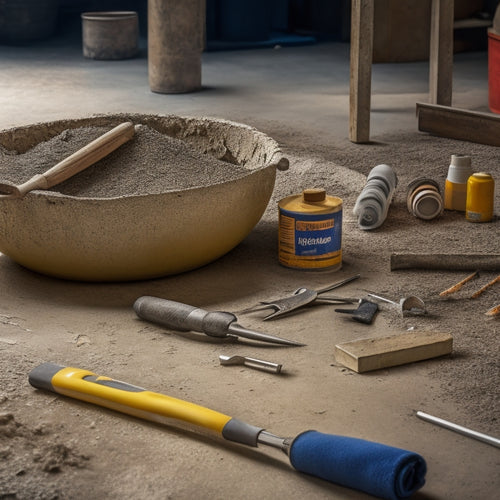
Top Tools for Accurate Concrete Estimation
Share
When estimating concrete needs, you'll want to calculate volume and yardage accurately to avoid costly mistakes. Tools like volume calculation software and concrete density calculators can help. Then, use a concrete mix proportion calculator to determine the exact amount of cement, sand, and aggregate needed. Next, slab thickness determination tools and ultrasonic thickness gauges guarantee structural integrity. Concrete cost estimator software streamlines project data, while visualization tools like 3D modeling software and project site mapping help identify potential issues. By leveraging these top tools, you'll be well on your way to precise concrete estimation, and taking the next step will reveal even more opportunities to optimize your project's success.
Key Takeaways
• Concrete mix proportion calculators determine precise amounts of cement, sand, and aggregate for ideal mix design and minimize waste.
• Slab thickness determination tools, like ultrasonic thickness gauges, ensure structural integrity by providing precise measurements.
• Concrete cost estimator software organizes project data, automates quantity takeoff, and enables real-time reporting for up-to-date insights.
• 3D modeling software creates detailed and interactive models, identifying potential issues and optimizing design pre-construction.
• Blueprint analysis tools dissect and visualize blueprints, identifying design flaws and discrepancies to prevent costly rework.
Calculating Concrete Volume Needs
Calculating Concrete Volume Needs
To accurately estimate concrete requirements, you must first determine the volume of concrete needed for your project. This involves calculating the area of the slab, wall, or footing and then multiplying it by the thickness of the concrete. This calculation is essential, as it directly affects the amount of concrete you'll need to order.
To get an accurate calculation, you'll need to take into account the concrete density, which typically ranges from 145 to 155 pounds per cubic foot. Once you have the area and thickness, multiply them together to get the volume in cubic feet. For example, if your slab has an area of 100 square feet and a thickness of 4 inches (0.33 feet), the volume would be 100 x 0.33 = 33 cubic feet.
Now, you'll need to perform a volume conversion to get the volume in cubic yards, which is the standard unit of measurement for concrete. There are 27 cubic feet in a cubic yard, so divide the volume in cubic feet by 27 to get the volume in cubic yards.
Measuring Yardage and Coverage
Once you've determined the volume of concrete needed in cubic yards, you can move on to measuring yardage and coverage, where you'll need to take into account the yield of the concrete mix and the slab's or wall's surface area to guarantee you're ordering the right amount of concrete for the job.
To accurately measure yardage, you'll need to calculate the coverage area of the concrete. This is typically measured in square feet per cubic yard. The yield of the concrete mix will also impact your yardage measurement, as it can vary depending on the specific mix design.
Here's a breakdown of the factors that affect yardage measurement and coverage calculation:
| Factor | Impact on Yardage Measurement |
|---|---|
| Concrete Mix Yield | Affects the amount of concrete needed per square foot |
| Slab or Wall Thickness | Impacts the total volume of concrete required |
| Surface Finish | Affects the coverage area of the concrete |
| Obstacles or Irregularities | Impacts the total yardage needed for the job |
Concrete Mix Proportion Calculator
With a solid understanding of yardage and coverage, you can now utilize a concrete mix proportion calculator to determine the precise amount of cement, sand, and aggregate required for your specific project, ensuring a strong and durable final product.
This tool is essential for achieving the ideal mix design, as it allows you to input the required strength, slump, and air entrainment for your project. By doing so, you'll receive the best proportion ratios for your mix, which is critical for meeting performance and durability specifications.
The calculator takes into account various factors, including the type of cement, aggregate, and admixtures, to provide you with accurate proportions. You can input specific values for cement, sand, and aggregate, or use default values based on industry standards.
The calculator then generates a detailed report outlining the exact quantities of each material required, ensuring you don't over- or under-order materials. By using a concrete mix proportion calculator, you'll minimize waste, reduce costs, and produce a high-quality concrete mix that meets your project's specific requirements.
Estimating Material Quantities
You'll need to accurately estimate the material quantities required for your concrete project, taking into account the calculated mix design proportions, to guarantee you have sufficient materials on hand while avoiding excess inventory.
To achieve this, you'll need to calculate the total volume of concrete required, considering the dimensions of the project area, including any obstructions or irregularities.
Next, you'll need to convert this volume into weight, using the density of the concrete mix. This will give you the total weight of each material required, including cement, aggregate, and water.
It's essential to achieve high estimation accuracy to minimize material waste and avoid costly reorders.
Even small discrepancies in estimation can result in significant material waste, which not only increases costs but also has environmental implications.
By using accurate estimation tools and techniques, you can ascertain that your material quantities are precise, reducing the risk of material waste and improving your project's overall efficiency.
Slab Thickness Determination Tools
To determine the ideal slab thickness for your concrete project, you must take into account various factors, including the intended use of the slab, the soil bearing capacity, and the desired level of structural integrity.
For instance, a slab intended for heavy industrial use will require a thicker slab than one designed for residential use.
To accurately measure slab thickness, you can use various tools, such as ultrasonic thickness gauges or electromagnetic cover meters.
These tools provide precise measurements, guaranteeing that your slab meets the required thickness for its intended use.
When it comes to concrete slab types, you'll need to take into account factors like the type of reinforcement, the concrete mix design, and the curing process.
For example, a reinforced concrete slab will require a different thickness than a fiber-reinforced polymer (FRP) slab.
Concrete Cost Estimator Software
When you're evaluating concrete cost estimator software, you'll want to contemplate how it handles project data management.
Can the software accurately organize and store project details, such as material quantities and labor costs, in a centralized database?
Project Data Management
Concrete cost estimator software simplifies project data management by providing a centralized platform to organize, analyze, and report on estimates, bids, and project costs in real-time. This enables you to make informed decisions quickly, reducing the risk of errors and delays. With data integration, you can easily import and export data from various sources, ensuring consistency and accuracy across all projects.
| Feature | Benefit |
|---|---|
| Centralized platform | Single source of truth for project data |
| Real-time reporting | Up-to-date insights for informed decision-making |
| Data integration | Seamless import and export of data from various sources |
| Collaboration tools | Enhanced project collaboration and communication |
Automated Quantity Takeoff
By leveraging automated quantity takeoff capabilities within your concrete cost estimator software, you can quickly and accurately calculate material quantities, eliminating manual errors and reducing project timelines. This feature allows you to import digital plans and models, automatically identifying and quantifying concrete elements such as slabs, beams, and columns. The software then generates a detailed bill of quantities, providing an accurate estimate of the materials required for the project.
Here are three key benefits of using automated quantity takeoff in your concrete cost estimator software:
-
Improved Accuracy: Automated software eliminates manual errors, ensuring that your quantity estimates are precise and reliable.
-
Time Savings: By automating the quantity estimation process, you can reduce project timelines and focus on higher-value tasks.
-
Enhanced Collaboration: Automated quantity takeoff enables you to share accurate estimates with stakeholders, improving communication and reducing misunderstandings.
Visualizing Your Concrete Project
When you're preparing to visualize your concrete project, you'll want to contemplate three key tools to help you get a clear picture of the site and its requirements.
You'll start by creating a detailed project site map, which will give you a bird's-eye view of the area and help you identify potential challenges.
From there, you can move on to 3D modeling software and blueprint analysis tools to further refine your understanding of the project's layout and components.
Project Site Mapping
You create a visual representation of your project site by generating a scaled diagram that accurately depicts the layout of the concrete structures, roads, and other relevant features. This process, known as project site mapping, is essential for concrete estimation as it helps you understand the project's scope and identify potential challenges.
With a detailed site map, you can pinpoint areas that require special attention, such as steep slopes or uneven terrain, and plan accordingly.
Here are three key aspects to focus on when creating your project site map:
-
Site layout: Verify that your diagram accurately represents the spatial relationships between different structures, roads, and features.
-
Elevation mapping: Incorporate elevation data to visualize the project site's topography and identify areas with significant changes in elevation.
-
Feature notation: Clearly label and annotate important features, such as drainage systems, utility lines, and existing infrastructure.
3D Modeling Software
With D modeling software, you can create a highly detailed and interactive 3D model of your concrete project, allowing you to visualize every aspect of the build, from foundation to finish.
This 3D visualization enables you to identify potential issues and optimize your design before construction begins. By integrating D modeling software with other tools, such as building information modeling (BIM) and computer-aided design (CAD), you can streamline your workflow and reduce errors.
Using D modeling software, you can also analyze complex structures and systems, such as rebar placement and concrete pours.
This level of detail enables you to create accurate estimates and reduce material waste. In addition, you can share your 3D model with stakeholders, including architects, engineers, and contractors, to make sure everyone is on the same page.
Blueprint Analysis Tools
Blueprint analysis tools allow architects, engineers, and contractors to meticulously dissect and visualize your concrete project's blueprint, identifying potential design flaws and discrepancies that could lead to costly rework or delays.
These tools enable you to extract valuable insights from your blueprint, ensuring that your project stays on track and within budget.
Here are three key benefits of using blueprint analysis tools:
-
Accurate plan interpretation: Blueprint software helps you interpret complex plans and identify potential issues, ensuring that your concrete project is built to spec.
-
Enhanced collaboration: By providing a shared understanding of the project blueprint, these tools facilitate collaboration between architects, engineers, and contractors, reducing errors and miscommunications.
-
Improved cost estimation: With accurate plan interpretation and enhanced collaboration, you can generate more accurate cost estimates, reducing the risk of cost overruns and project delays.
Frequently Asked Questions
Can I Use These Tools for Estimating Asphalt or Other Materials Too?
When you're estimating asphalt or other materials, you'll find that the tools you use for concrete estimation can be adapted with some adjustments.
You'll need to evaluate the unique properties of each material, like density and volume, for accurate calculations.
Are There Any Free Concrete Estimation Tools Available Online?
You're looking for free concrete estimation tools available online. Yes, there are several options!
You can utilize online calculators like the Concrete Volume Calculator or the Concrete Cost Calculator, which provide accurate estimates based on input parameters.
Before choosing a tool, be certain to read user reviews to guarantee it meets your specific needs.
These free resources can help you estimate concrete quantities and costs efficiently, saving you time and money.
How Do I Account for Concrete Wastage in My Estimates?
Imagine pouring concrete into a leaky bucket - that's what happens when you don't account for wastage.
To avoid this, you'll need to factor in wastage rates, typically ranging from 2-5%. You can calculate this by using methods like the 'volume method' or 'weight method'.
Be precise, and consider variables like slab thickness, pour size, and material type to get an accurate estimate.
Can I Use Concrete Estimation Tools for Non-Standard Slab Shapes?
When dealing with non-standard slab shapes, you'll need to guarantee your estimation tool can handle complex geometries.
Look for software that allows you to input custom shapes or irregular boundaries. This will enable you to achieve high estimation accuracy, even with unusual slab designs.
Are These Tools Suitable for Large-Scale Commercial Concrete Projects?
When you're building a skyscraper, every detail matters - it's like trying to solve a complex puzzle blindfolded. You can't afford to get concrete estimation wrong.
Fortunately, advanced tools are designed to handle large projects with ease. For commercial applications, these tools provide precise calculations, ensuring you order just the right amount of concrete.
They can even accommodate complex shapes and irregular slab designs, making them ideal for large-scale commercial concrete projects.
Conclusion
Now that you've mastered the top tools for accurate concrete estimation, you're ready to pour the foundation for a successful project.
With these precision instruments in your toolkit, you'll be able to build a concrete plan that's as solid as, well, concrete.
Don't let estimation errors crack your confidence - with these tools, you'll be able to lay the groundwork for a project that's structurally sound and financially stable.
Related Posts
-

Top Tools for Repairing Cracked Concrete Surfaces
When tackling a cracked concrete surface repair, you'll need the right tools to guarantee a durable fix. Start with e...
-

Essential Power Tools for DIY Concrete Sculpting
As you begin DIY concrete sculpting, you'll need a strategic selection of power tools to achieve professional-grade r...
-

Must-Have Tools for Concrete Planter Projects
As you commence your concrete planter project, you'll need a range of specialized tools to achieve professional-grade...


